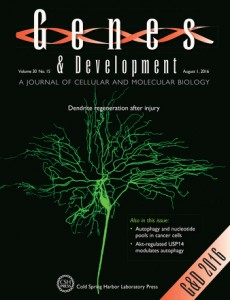
Duronio, McKay, Strahl, Matera co-authored the paper that appeared in the August 2016 publication of Genes and Discovery.
The following article, highlighting the work of Robert Duronio, PhD; Daniel McKay, PhD; Greg Matera, PhD; Brian Strahl, PhD., appeared in the September 1, 2016 edition of UNC Health Care and UNC School of Medicine’s Vital Signs newsletter and highlights findings published in the Volume 30, No. 15 release of Genes and Discovery.
UNC School of Medicine researchers discovered that the major developmental function of heterochromatin – a form of tight DNA packaging found in chromosomes – may be to suppress activity of virus-like DNA elements known as transposons or “jumping genes,” which can otherwise copy and paste themselves throughout the genome, potentially destroying important genes, and causing cancers and other diseases.
Read more at the UNC School of Medicine Newsroom…
